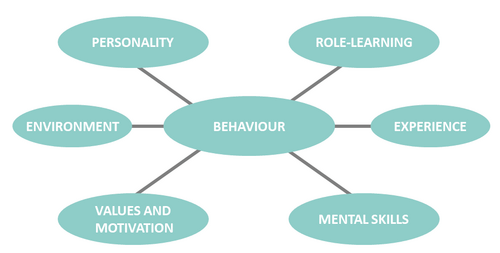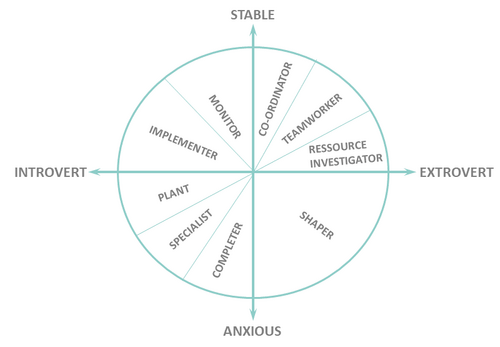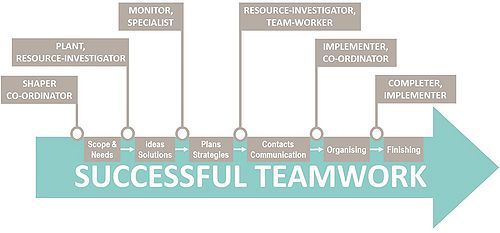Belbin's Team Roles
Developed by André Agertoft Condamine
Contents |
Abstract
When dealing with Project Human resource management it is essential for a project manager to develop a suitable project team. This process requires focus on not only developing the overall competencies of a team, but also team interaction and environment to enhance project performance. To cope with this, it is essential that a project team consist of diverse members that can carry out different team roles to boost synergetic performance. For this, Dr. Meredith Belbin studied the importance of team role for many years at Henley University. Here, Belbin developed different team roles based on nine years of empiric study of team analysis, games etc. The study resulted in the discovery of 9 different team roles. It turned out to be possible to describe the inner psychological dynamics of the person, and to describe what effects this would have, partly on the employees and partly on a team. Additionally, the study also showed that it could be predicted how a team will manage from the composition of the team. Belbin’s work led to a widely used set of tools, which can be used to analyse and diagnose project teams for further performance enhancement. The following consists of a hands-on ‘need to know’ approach on Belbin’s team role tools, how to use these, and why.
History
In 1969, Dr. Meredith Belbin was asked to investigate team performance alongside Roger Mottram, Bill Harston, and others. For this, Dr. Belbin and his colleagues decided for a business game as a framework to study the performance of teams. Here, a business game would produce tangible financial results, which could be used to measure performance and differentiate between successful teams and failing teams. While now having covered the output of a team, Dr. Belbin aimed at measuring the input in terms of individual team-member characteristics. Therefore, Dr. Belbin assembled a psychometric test battery consisting of a measure of reasoning ability, personality, and outlook. For this, the Critical Thinking Appraisal (CTA), 16 scales of the Cattell personality inventory, and the Personal Preference Questionaire was used. After three years of studies, a tendency of the more successful teams was discovered to be higher scores of on mental abilities as measured by the CTA and to have a particular set of personality characteristics. By use of these tools Dr. Belbin and his colleagues found the successful team member to have the traits of being practical, down to earth, disciplined, orderly and trusted [REF]. However, as team performance not solely rely on some specific traits, Dr. Belbin started to focus on the performance of teams which was assembled in different combinations regarding the profile generated from the previous tools. This led to the conclusion that people who scored high in all the tests had a habit of competing to an extent that would suppress team performance [REF]. From here, Dr. Belbin identified the essential types of contributions that gives balance to a team and enhanced performance. To give an indication of the different types of contributions a person can have, Dr. Belbin and his team created 8 ‘Team roles’ that were noticeable by particular patterns of psychometric scores in the different tests [REF]. Additionally, a ninth role “the specialist” was added later after obtaining experience from theory in the industry [Ref].
What is a role?
The basic idea in Dr. Belbins theory is that it is possible to distinguish between a functional role and a team role. When working in project teams most people take on a role based on personal abilities and preferences. By understanding the roles of each member of a team a project manager can improve performances drastically. However, in order to do this, it is necessary for a team to understand both the functional-role and team-role of each team member.
- The Functional-Role is the contribution to the team based on acquired knowledge and professional experience. This role can easily be detected by the corporate position of the team member as people mostly are hired for the position based on how well they fitt to the position. Hence, the description of the posistion can often be used to describe the team members functional role
- The Team-Role is our contribution to the team based on personal ability and characteristics. This role is harder to discover as requires extensive knowledge about the team memebers personal attributes such as values and motivation, personality, and mental skills. This is where Belbins team roles step in as a tool to discover and interpret the prefered team-role of a team member.
Belbin's team roles as a tool
After having established the nine different team-roles, Dr. Belbin and his colleagues camo up with an instrument for quantifying individuals’ team-role preferences. This instrument is known as the Belbin Team Role Self‐Perception Inventory (SPI). The instrument works as an extensive questionnaire that produces a quantitative summary of its respondent’s resemblance with each team role. However, the SPI also consist of a filter mechanism, which detects if respondents are trying to appear more desirable for team performance and labels them as ‘dropped’. This ensures that the output is more accurate when dealing with different kinds of people.
The current version of the SPI consists of 70 inventories which are a series of short questions where the respondents select and weights the answers.
As an example, one section focuses on the question “how do you believe you contribute to a team?”. Here, there are 8 possible answers, which the respondents will have 10 points to distribute to the different answers to describe their role.
In general, These different inventories consist of questions that seeks information of the respondent’s behaviour through questioning six factors: values and motivation, personality, mental skills, experience, Role-learning, and environment.
The tool has since its early days gone through several modifications, which includes: re‐defining some of the roles as they carried unwanted associations. Therefore, the role of Company-Worker was changed to Team-Worker, and the Chairman became Co‐ordinator. Furthermore, the addition of the Specialist changed the framework that had been used until now to construct balanced teams. However, the biggest change was the digitalisation of the tool. This meant that the tool now became an automated computer‐based tool with a more refined scoring mechanism. When using Belbin's team roles, the SPI tool will produce a set of reports containing either the 'Self-Perception Only Team-Role Report' (SPOTRR) or the 'team and Group Team-Role Report' (TGTRR). These two differs as the SPOTRR only considers a report explaining the team-role of the respondent, where the TGTRR considers a report explaining the individual role as well as the team dynamics of a group of respondents. Here, the TGTRR is mostly for evaluating an existing team, whereas the SPOTRR acts as a tool to provide the respondent and their organisation with information on individual role preferences for future team formations.
Belbin's Team Roles
| Roles | Traits | Contribution | Allowable weakness | These needs to be | When dealing with, Do | When dealing with, Don't |
|---|---|---|---|---|---|---|
| Plant | Crative, Imaginative, Free thinking.
Generates ideas and solves difficult problems. |
Plants are the ideal idea generators. They may not be very practical or very good at communicating, however they excel at injecting new ideas into the team. Therefore, Dr. Belbin used the term “Plants” to categorise this team role as such individuals’ plants ideas into the group. However, it does not matter if the idea of a plant seems insane at the time but usually these ideas turns out to be valuable for the team. | Ignores incidentals.
Too preoccupied to communicate effectively. |
Plants need to be intelligent, have a creative disposition and the ability to think laterally without any prompting on the part of others, or be afraid of taking a minority standpoint. | Feed them with questions and problems.
Encourage them to develop their ideas. |
Expect them to conform.
Criticise ideas that have no immediate application. |
| Resource investigator | Outgoing, Enthusiastic, Communicative, Explores oppertunities and develops contact. | Resource Investigators are usually extraverts with the trait of being extensively curios. They usually like to meet people and explore new ideas. They often bring back these ideas when disca and they develop them. In
that sense they offer a creative input to the team. And so could be compared with Plants. The difference is that where Resource Investiators are concerned, the ideas may not be g , y their own. But, in the end does it matter? Good ideas are good ideas wherever they come from. And certainly Resource Investigators protect us from that awful “not invented here syndrome”. |
Over optimistic, Loses interest once initial enthusiasm has passed. | Resource investigators are an essential contribute to a team avoiding losing sight of the outside world such as customer demand. Therefore, the Resource investigators need to be able to include the outside world by being able to actively communicate, investigate, and apply external resources. | ||
| Co-ordinator | Co-ordinators are strong and acceptable individuals that can see the big picture of a project and apply common sense. Here, Co-ordinators can tolerably assemble team members for specific purposes and improve output. This is often described as a less common talent that depends on the individuals' capability of having a sincere interest in the people while keeping focus on the goals. | A good Co‐ordinator needs to be able to discover hidden skills of team members and know how to stimulate them to get the best out of the members while letting others take the credit. | ||||
| Shaper | Shaper are often experienced as tough and as a hard-driving force in teamwork. A shaper can easily ruin the team spirit by repeating what the team is supposed to be doing and verbally force the team to it. These individuals are easily identified by their bluntness, determination, and keenness on unpopular decisions. Furthermore, Shapers are exceptional achievers who strive when meeting deadlines. Therefore, Shapers are superb at saying the things people sometimes do not want to hear but needs to hear. Hence, Shapers often have one of two effects on a team. Either they brutally disrupt the performance. However, if the Shapers are properly aligned in a balanced team, they will drive higher performance in a team. | A good Shaper needs a strong personality in order to get results by driving people forwards. However, nobody likes being told what to do. Therefore, it is essential to be careful whether the shaper fits the team. | ||||
| Monitor Evaluator | The true Monitor is infrequently one of the enthusiasts within a team. Mostly because this would prejudice good judgement. Furthermore, a Monitor will rarely participate in the idea phases as this would create a biased evaluation. Generally, the monitoring and evaluation processes are vital in teamwork to get the right output. The role of the Monitor may appear unglamorous to many as it is a more reluctant team role. But if the team decisions are ensured to be right, the team will experience an enhanced output. | A good monitor needs to be an intelligent fair-minded individual who can produce an unbiased evaluation of processes. Therefore, it is important that Monitors have capabilities within analysis and debate, which is
always in demand when problematic problems are concerned. |
||||
| Teamworker | ||||||
| Implementer | ||||||
| Finisher | ||||||
| Specialist |
Team Dynamics
The team roles can be position at a scale from being an extrovert to introvert and being stable to restless. Here, stable individuals are most often sociable and can mostly be accepted by others who experience them to be balanced individuals. However, they also tend to be experienced as careless, lazy and to rarely do their best unless they are under pressure [REF].
Restless individuals are often easy to influence. If restlessness is associated with high values of self-restraint and discipline, it will often be converted into energy. If there is little self-discipline, restlessness will often either have a disruptive effect on others or result in an unacceptably high degree of internal stress [REF]. Extroverted individuals are aware of the outer world of people and activities. They direct energy and attention outward, get energy by interacting with other people, and by acting [ref]. Introverted individuals are aware of their own inner world of ideas and experiences. They direct their energy and attention inward and get energy by reflecting on their thoughts [REF].
Why use Belbin's team-roles for project-team management
The idea behind using the team roles is first and foremost to establish a framework and language for discussing collaboration. Furthermore, it can be used to understand the strengths and weaknesses of the team members and utilise/compensate these for the benefit of improved performance by having a well-balanced project team. Moreover, the tool can be used to further build on team members existing strengths and identify possible conflicts with people of similar preference and roles so that these strength are used to the full extend. To enhance trust, openness and maximise co-operative working To realise team role gaps or overlaps present within a team
Build the Perfect project-team
The high performing prpoject teams share the ability to draw of everyone’s strengths and leverages team members preferences when needed throughout the work process. Being more flexible about the composition of teams (and setting up and disbanding teams for specific purposes) can help to ensure that the most suitable individuals are able to contribute, regardless of rank or status. It can also prevent stagnation and circumvent interpersonal conflicts or ineffective management diplomatically and without undermining traditional hierarchical structures. Once the team has been assembled with the right roles and responsibilities, they will need ongoing support to ensure that they are working productively together. Remember to revisit the team role discussion and encourage team performance by asking participants to come up with observations regarding strengths and weaknesses of the team. Encourage participant to come up with action points to improve team performance To build the perfect project-team the following basic framework have to be identified:
- Shared values - The team values and norms correspond with the team members understanding of right and wrong
- Shared vision and objectives - Everybody understands and accepts the objectives
- Acceptance of plan - A plan, which is accepted by everybody and gives a clear picture of what has to be done
- Task allocation - Allocation of tasks and resources. Everybody understands how they can contribute to the process
- Open communication - Communication, both formal and informal, is encouraged
- Cooperation - People interrelate, improvise and support each other – the individual feels responsible for the process as such, not only his own task
Use the team-roles for enhanced performance
Limitations
References
Comming up https://www.belbin.com/about/team-role-spotlight-resource-investigator/


